Valorant, Riot Games’ tactical shooter, has captivated players worldwide with its compelling blend of precise gunplay and strategic team dynamics. As a former professional Valorant player, I aim to demystify the ranking system that defines competitive play in 2025.
This guide offers a deep dive into Valorant’s ranking mechanics, agent selection strategies, and the current meta, equipping players with the knowledge they need to ascend the competitive ladder.
Introduction to Valorant’s Ranking System

Valorant’s ranking system is a sophisticated structure designed to assess and categorize players based on their skill levels. It serves as a metric for players to gauge their progress, offering a clear path from novice to elite status. The system not only promotes personal growth but also fosters a competitive environment where players must continually adapt and refine their skills.
The Purpose of the Ranking System
The primary goal of Valorant’s ranking system is to create balanced matches that provide both a challenge and a fair chance of victory. By categorizing players into different skill tiers, the system ensures that matches are competitive, rewarding skillful play and strategic thinking.
How the Ranking System Works
The system operates on a combination of visible ranks and hidden metrics, such as Matchmaking Rating (MMR). While players see their rank, which changes based on match outcomes, MMR is a more complex calculation that determines the quality and difficulty of opponents faced in each match.
For a detailed overview of the ranking system, visit our Valorant rank guide.
Understanding the Ranking Tiers
Valorant’s competitive ranks are structured into nine tiers, each representing varying levels of skill and game understanding. These tiers are further divided into specific ranks, creating a nuanced system that reflects a player’s journey and progression.
The Nine Tiers of Valorant
- Iron: The starting point for most players, focusing on learning the basics of the game.
- Bronze: Players begin to develop a fundamental understanding of game mechanics and strategies.
- Silver: A tier where players refine their skills and start to grasp team dynamics and positioning.
- Gold: Players here demonstrate competent game knowledge and improved mechanical skills.
- Platinum: Marks the transition into more strategic play, with players showcasing better coordination and map awareness.
- Diamond: Players exhibit strong individual skills and strategic insights, often participating in more coordinated team plays.
- Ascendant: Reserved for the top percentage of players, requiring consistent performance and advanced strategies.
- Immortal: A tier for elite players, characterized by high-level strategy and exceptional gameplay.
- Radiant: The pinnacle of Valorant ranks, occupied by the best players globally, including pro players and top-tier enthusiasts.
Rank Distribution and Player Behavior
As players progress through these tiers, they encounter increasingly challenging opponents, necessitating continuous improvement and adaptation. The distribution of players across these tiers ensures that each rank provides a distinct level of competition, with Radiant being the ultimate test of skill and strategy.
Matchmaking Rating (MMR) Explained
MMR is the backbone of Valorant’s ranking system, influencing match outcomes and player progression. While MMR is not visible to players, understanding its mechanics is crucial for those aiming to climb the ranks.
What is MMR?
MMR is an internal rating that quantifies a player’s skill level. It is used to match players against opponents of similar skill, ensuring balanced and competitive matches. MMR takes into account various factors, including win-loss records, individual performance, and the skill levels of opponents.
How MMR Affects Rank
- Win-Loss Impact: Winning increases your MMR, while losing decreases it. However, the extent of change depends on the MMR of your opponents. Beating a higher-rated team yields a greater MMR increase, while losing to a lower-rated team results in a more significant decrease.
- Performance Considerations: Individual performance can influence MMR adjustments. Consistently high performance, even in losses, can mitigate negative MMR changes.
- Promotions and Demotions: MMR thresholds determine when players are promoted or demoted between ranks. Achieving a series of wins can trigger a promotion, while consecutive losses may lead to demotion.
Factors Influencing Rank Progression
Several variables determine how players advance through Valorant’s ranks, each contributing to the complexity and dynamism of the ranking system.
Match Outcomes
The primary determinant of rank progression is the outcome of matches. Winning games is crucial for climbing ranks, but the system also considers the relative MMR of opponents. Victories against higher-rated teams yield greater rank gains, emphasizing the importance of challenging engagements.
Individual Contributions
While team success is paramount, individual performance also plays a role in rank progression. High kill counts, assists, effective utility usage, and overall contribution to team objectives can positively impact rank changes, particularly when MMR is close to a promotion or demotion threshold.
Consistency and Adaptability
Consistent performance across matches is key to rank progression. Valorant’s ranking system rewards players who demonstrate steady improvement and reliability. Adaptability, or the ability to adjust strategies based on opponent behavior and map dynamics, is equally crucial for sustained success.
Agent Selection and Meta Considerations
In Valorant, choosing the right agents and understanding the current meta are critical components of competitive play. Each agent brings unique abilities that can significantly influence match outcomes, making strategic selection essential.
S-Tier Agents in the Current Meta
- Jett: Renowned for her unmatched mobility and entry fragging potential, Jett is a staple in most team compositions. Her Tailwind ability allows for aggressive plays, while Blade Storm offers lethal precision during eco rounds.
- Sova: A key initiator, Sova excels at gathering information and controlling the battlefield. His Recon Bolt and Owl Drone provide vital intel, while Hunter’s Fury can disrupt enemy positioning and secure crucial kills.
- KAY/O: As a utility suppressor, KAY/O is invaluable in a meta dominated by utility-heavy strategies. His ZERO/point ability can disable enemy setups, while FLASH/drive and NULL/cmd enhance team coordination during site takes.
For more insights into agent selection and current meta strategies, check out our Valorant agent tier list.
Adapting to Meta Shifts
The Valorant meta is dynamic, influenced by patches, new agent releases, and evolving strategies. Staying informed about meta shifts is essential for maintaining competitiveness. Regularly review patch notes and professional play trends to adapt your agent choices and strategies accordingly.
Role Specialization and Flexibility
Specializing in specific roles, such as entry fragger, support, or controller, can enhance your effectiveness in matches. However, flexibility is equally important. Being able to adapt your playstyle based on team needs and opponent strategies is a valuable skill that can significantly impact match outcomes.
Strategies for Climbing the Ranks
Ascending the competitive ranks in Valorant requires a combination of skill, strategy, and teamwork. Here are some strategies to help you climb effectively:
Effective Communication and Teamwork
Communication is the cornerstone of successful team play. Make clear callouts, share information about enemy positions, and coordinate utility usage with your team. Establishing strong teamwork dynamics can lead to more cohesive strategies and better match outcomes.
Mastering Map Knowledge and Positioning
Understanding map layouts, common angles, and strategic positions can give you a tactical advantage in engagements. Use this knowledge to anticipate enemy movements, plan your attacks, and establish strong defensive setups.
Leveraging Utility Usage
Mastering the use of agent abilities is crucial for gaining an edge in matches. Utilize utility to gather information, control space, and disrupt enemy plans. Practice agent-specific lineups and setups to maximize your effectiveness and support your team’s objectives.
Maintaining a Positive Mindset and Adaptability
A positive mindset is essential for sustained success in Valorant. Stay focused on improvement, learn from losses, and adapt your strategies based on opponent playstyles and match dynamics. Being open to change and willing to experiment with different approaches can lead to valuable insights and breakthroughs.
Common Challenges and How to Overcome Them
Navigating Valorant’s competitive landscape presents several challenges, but with the right mindset and strategies, these can be overcome.
Dealing with Toxicity
Toxicity can hinder team morale and performance. Address negative behavior by muting disruptive players if necessary and focusing on maintaining a positive and constructive environment for your team. Encourage teamwork and emphasize the importance of collaboration for achieving success.
Handling Losing Streaks
Losing streaks can be demoralizing, but they are part of the learning process. Analyze your gameplay to identify areas for improvement, seek feedback from teammates, and take breaks if needed to reset mentally. Remember that setbacks are opportunities for growth and development.
Balancing Individual and Team Performance
While individual performance is important, prioritize team success. Support your teammates, adjust your playstyle to fit team needs, and focus on securing round victories. Balancing personal contributions with team objectives can lead to more consistent and rewarding match outcomes.
Valorant’s Ranking System Updates in 2025
In 2025, Valorant has introduced several updates to its ranking system to enhance player experience and competitive integrity:
- Enhanced MMR Transparency: Players now have more insight into their MMR changes, helping them understand their rank progression better. This transparency allows players to make informed decisions about their gameplay and strategies.
- Improved Matchmaking Accuracy: Adjustments to the matchmaking algorithm ensure fairer and more balanced matches, reducing the likelihood of skill disparities and promoting more competitive engagements.
- New Rank Decay Mechanism: To maintain competitive integrity, inactive players may experience rank decay, encouraging consistent play and ensuring that ranks accurately reflect current skill levels.
Stay updated with the latest changes and developments in Valorant’s ranking system by visiting our Valorant updates page.
Conclusion
Climbing the ranks in Valorant is a rewarding journey that requires a combination of skill, strategy, and teamwork. By understanding the ranking system, adapting to the meta, and continuously refining your gameplay, you can achieve your competitive goals. Remember, the journey through Valorant’s ranks is as much about personal growth and learning as it is about reaching Radiant.
For more in-depth guides, strategies, and insights into Valorant, explore our comprehensive resources at valorant.org.uk. Whether you’re a casual player or an aspiring pro, our content is designed to help you improve and succeed in the vibrant world of Valorant.






